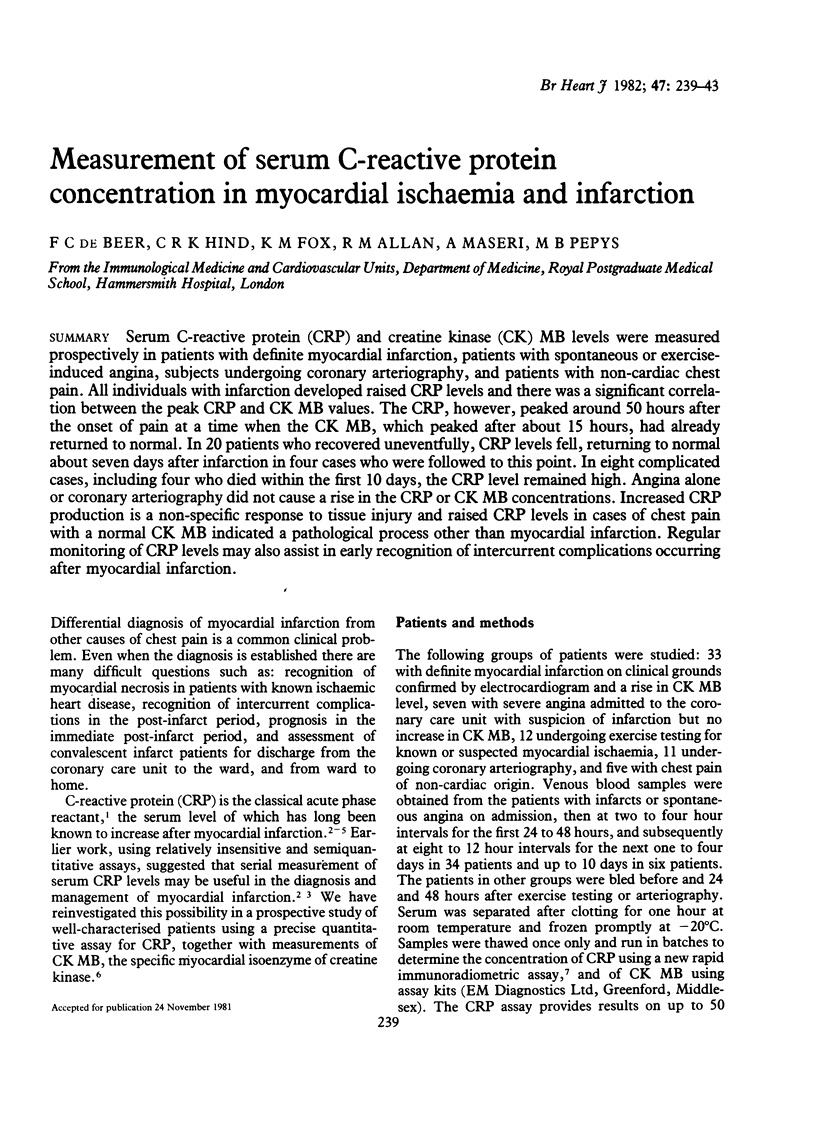Abstract
Serum C-reactive protein (CRP) and creatine kinase (CK) MB levels were measured prospectively in patients with definite myocardial infarction, patients with spontaneous or exercise-induced angina, subjects undergoing coronary arteriography, and patients with non-cardiac chest pain. All individuals with infarction developed raised CRP levels and there was a significant correlation between the peak CRP and CK MB values. The CRP, however, peaked around 50 hours after the onset of pain at a time when the CK MB, which peaked after about 15 hours, had already returned to normal. In 20 patients who recovered uneventfully, CRP levels fell, returning to normal about seven days after infarction in four cases who were followed to this point. In eight complicated cases, including four who died within the first 10 days, the CRP level remained high. Angina alone or coronary arteriography did not cause a rise in the CRP or CK MB concentrations. Increased CRP production is a non-specific response to tissue injury and raised CRP levels in cases of chest pain with a normal CK MB indicated a pathological process other than myocardial infarction. Regular monitoring of CRP levels may also assist in early recognition of intercurrent complications occurring after myocardial infarction.
Full text
PDF




Selected References
These references are in PubMed. This may not be the complete list of references from this article.
- ELSTER S. K., LEVINGER E. L., LEVY H. Study of C-reactive protein in the sera of patients with acute myocardial infarction. Ann Intern Med. 1957 Jan;46(1):68–78. doi: 10.7326/0003-4819-46-1-68. [DOI] [PubMed] [Google Scholar]
- Johansson B. G., Kindmark C. O., Trell E. Y., Wollheim F. A. Sequential changes of plasma proteins after myocardial infarction. Scand J Clin Lab Invest Suppl. 1972;124:117–126. doi: 10.3109/00365517209102759. [DOI] [PubMed] [Google Scholar]
- KROOP I. G., SHACKMAN N. H. The C-reactive protein determination as an index of myocardial necrosis in coronary artery disease. Am J Med. 1957 Jan;22(1):90–98. doi: 10.1016/0002-9343(57)90340-6. [DOI] [PubMed] [Google Scholar]
- Kushner I., Broder M. L., Karp D. Control of the acute phase response. Serum C-reactive protein kinetics after acute myocardial infarction. J Clin Invest. 1978 Feb;61(2):235–242. doi: 10.1172/JCI108932. [DOI] [PMC free article] [PubMed] [Google Scholar]
- Pepys M. B. C-reactive protein fifty years on. Lancet. 1981 Mar 21;1(8221):653–657. doi: 10.1016/s0140-6736(81)91565-8. [DOI] [PubMed] [Google Scholar]
- Rogers W. J., McDaniel H. G., Smith L. R., Mantle J. A., Russel R. O., Jr, Rackley C. E. Correlation of angiographic estimates of myocardial infarct size and accumulated release of creatine kinase MB isoenzyme in man. Circulation. 1977 Aug;56(2):199–205. doi: 10.1161/01.cir.56.2.199. [DOI] [PubMed] [Google Scholar]
- Shine B., de Beer F. C., Pepys M. B. Solid phase radioimmunoassays for human C-reactive protein. Clin Chim Acta. 1981 Nov 25;117(1):13–23. doi: 10.1016/0009-8981(81)90005-x. [DOI] [PubMed] [Google Scholar]


